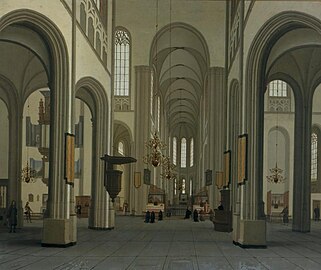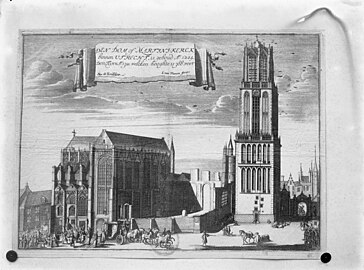St. Martin's Cathedral, Utrecht
This article includes a list of general references, but it lacks sufficient corresponding inline citations. (March 2020) |
| UNESCO World Heritage Site | |
|---|---|
 View of the cathedral and tower | |
| Location | Utrecht, Netherlands |
| Criteria | Cultural: (ii), (iii), (iv) |
| Reference | 1631 |
| Inscription | 2021 (44th Session) |
St. Martin's Cathedral, Utrecht, or Dom Church (
It was once the Netherlands' largest church, but the nave collapsed in a storm in 1674 and has never been rebuilt, leaving the tower isolated from the east end.
The building is the one church in the Netherlands that closely resembles the style of classic Gothic architecture as developed in France. All other Gothic churches in the Netherlands belong to one of the many regional variants. Unlike most of its French predecessors, the building has only one tower, the 112-metre-high (367 ft) Dom Tower, which is the hallmark of the city.
In the joint 2021, 2022 session of the World Heritage Committee the cathedral, Dom Tower, and the Domplein was inscribed as a UNESCO World Heritage Site as part of the Lower Germanic Limes, for its Roman archaeological remains within the square.
History

The first chapel in
The church was repeatedly destroyed by fires and then rebuilt. A
In 1580 the Utrecht city government
The Catholic Church remained strong within Utrecht following the Reformation but was legally obliged to worship discreetly in clandestine churches (schuilkerken). One of these churches, St. Gertrude's, later became the principal cathedral of the Old Catholic Church of the Netherlands.
The Catholic Church, during the 1853 reestablishment of the episcopal hierarchy in the Netherlands, designated the former St. Catherine's Church of the Carmelites as the cathedral of the Roman Catholic Archdiocese of Utrecht.
-
View of St. Martin's Cathedral from the north, before the nave's collapse. Etching after Steven van Lamsweerde, 1660
-
Interior view byHendrick van Vliet, 1674 (the year of the storm)
-
View of the choir from the north showing the collapsed nave. Engraving by I. van Vianen, 1697
-
Military aerial view of Domplein and its environs, 1920–1940. Nederlands Instituut voor Militaire Historie.
-
The church as seen from the tower, in front the temporarily rebuilt section, 2004
Current-day church
What remains of St. Martin's today are the choir, the transept and the Dom Tower. The central nave of the cathedral which collapsed in the storm of 1674 is now a square with large trees, the
In 2004, 750 years after construction began, the collapsed parts were temporarily rebuilt in scaffolding material. The scaffolding was also blown down in a storm, like the original nave. In 2013, a project started to expose the cathedral's
Since 2019, the Dom tower has been undergoing major renovations. When the church spire was temporarily removed, between November 2021 and July 2022, the Nieuwe Kerk in Delft briefly became the church with the tallest tower in the Netherlands. The renovation works are scheduled to finish in the summer of 2024.[1]
-
Exterior of St. Martin's Cathedral
-
View from the cloister
-
Excavation work on the foundations of the central nave pillars, 2013
-
Dom tower under renovation, 2019
Burials and memorials in the Dom
Utrecht was an important city in the western
The only medieval tomb of importance to remain relatively unscathed in the cathedral is that of the 14th-century Bishop Guy of Avesnes – the brother of John II, Count of Holland, Hainaut, and Zeeland.
There are many other beautifully carved burial slabs and memorials in the cathedral. Of particular note is the monumental cenotaph, which contained the heart of the 16th-century Bishop George van Egmond.
References
Citations
- ^ Harmsen, Judith (15 July 2022). "Utrechtse Domtoren weer officieel de hoogste kerktoren van Nederland". Trouw, DPG Media. Retrieved 8 October 2023.
Bibliography
- Borst, P. (1997). Graven en begraven in de Dom van Utrecht (in Dutch). Bunnik: Reinders. ISBN 9789072507266.
- Bruin, Renger E. de, ed. (2000). Geschiedenis van de stad Utrecht : "een paradijs vol weelde" (in Dutch). Utrecht: Matrijs. ISBN 9789053451755.
- Hulzen, Albertus van (1944). Utrecht, De Geschiedenis en de Oude Bouwwerken. Heemschut-serie (in Dutch). Vol. deel 39. Amsterdam: Albert de Lange. OCLC 645419597.
External links
- domkerk.nl, the church's official website










